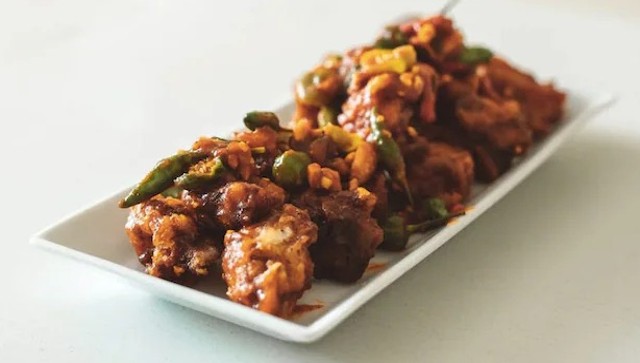Desi Chinese is a popular cuisine in India. Food fans have long loved Gobi Manchurian, a fusion meal that usually consists of cauliflower florets wrapped in a spicy red sauce. However, Goa’s Mapusa has banned the delicacy from stalls and feasts due to concerns over artificial colouring and hygiene. The ban The Mapusa Municipal Council (MMC), late last month, unanimously banned Gobi Manchurian stalls in Shree Bodgeshwar Zatra in Mapusa. Some of the reasons behind the anti-gobi Manchurian sentiments are bad hygiene, the use of synthetic colours, and even the usage of powdered laundry detergent and questionable sauces, according to The Times of India. MMC chairperson Priya Mishal told the newspaper, “The councillors opined that such vendors operate in unhygienic conditions and use synthetic colours for making gobi Manchurian and that is what has prompted us to ban the sale of this dish." A senior food safety officer (FSO) at the FDA said that sellers had been fined by the authorities for using inferior sauce that was unsafe for consumption. “They keep the quality sauce on display but use substandard ones for the preparation of gobi manchurian. They use some kind of powder in the flour and cornstarch in the batter so that after deep frying, the cauliflower florets remain crispy for a long time," the official told TOI. According to the officer, this powder is a sort of reetha, used in washing clothes. “Have you wondered why you pay Rs 70-100 for one plate in restaurants and Rs 30-40 in zatras? It’s because of this," he added. As per the FDA official, since the operators of these stalls are constantly moving and challenging to prosecute, prevention in these cases is simpler. “By the time the reports of drawn samples are out, vendors disappear from the spot,” he was quoted saying by another TOI report. Similar sentiments Foodies and tourists alike have been puzzled by the state’s pervasive dislike of the dish over the past few years. Apart from MMC, other Goan civic organisations have also declared war on Gobi Manchurian. In 2022, the FDA ordered the Mormugao Municipal Council to restrict the number of stalls serving Gobi Manchurian during the renowned Vasco Saptah festival held at the Shree Damodar temple, reported NDTV. Such stalls at Ponda’s “Kapileshwari” and “Sateri Devi” zatra had already been raided by the FDA for reportedly running in unhygienic conditions. Explaining the negative sentiment at the Vasco saptah, TOI quoted a senior town councillor as saying, “The FDA had told the MMC that such stall operators engage in preparing the food item behind the stall area under unhygienic conditions without proper facilities. However, in 2023, a decision was taken in this regard at the last minute to allow the cooking and sale of Gobi Manchurian by the municipality as councillors were divided over this issue.” The FSO advised that to maintain fundamental hygienic practices, zatra or feast organisers should offer vendors water and disposal facilities before assigning stalls. Vendors’ response Vendors, however, claimed that the raiding officials’ destruction of one specific food item and seizure of the gas cylinders made the action against it seem out of place. “We did receive instructions from officials not to sell Gobi Manchurian. But this rule should be applied to all, and the chosen ones should not be given different treatment. Not all are using banned or substandard materials. Because of a few individuals, why is the municipality targeting all of us,” one asked. The Gobi Manchurian stall owners also claimed that even when hygiene norms are upheld, sales of this specific good item are being targeted. “When we are maintaining hygienic conditions, why stop the business?" asked a vendor on condition of anonymity. Origins of Gobi Manchurian The origins of Gobi Manchurian come from its chicken counterpart. Nelson Wang, a pioneer of Chinese cuisine from Mumbai, who was the caterer at the Cricket Club of India in the 1970s, is known to have invented Chicken Manchurian. When he was challenged to come up with something novel, he deep-fried chicken nuggets in a hot batter made of cornflour and served them either dry or with a tart gravy that included vinegar, sugar, soy sauce, and occasionally tomato sauce. Gobi Manchurian is the vegetarian alternative to this dish. Using artificial colours in food Artificial food colours are responsible for the bright colours of candies, sauces, jams and pickles. According to Healthline, food dye consumption has increased by 500 per cent in the last 50 years. Children are reportedly the biggest consumers. The Cleveland Clinic suggests artificial colours may cause serious side effects such as hyperactivity in children, behavioural changes like irritability, depression and anxiety, hives and asthma, and increase the risk of growing cancerous tumour. With inputs from agencies
What’s wrong with Gobi Manchurian? Why has a town in Goa banned the dish?
FP Explainers
• February 5, 2024, 14:24:26 IST
Goa’s Mapusa has banned Gobi Manchurian from street food stalls. Authorities have questioned hygiene and the use of synthetic colours, and even powdered laundry detergent while cooking the dish. Some say the sauces are a problem
Advertisement
)
End of Article